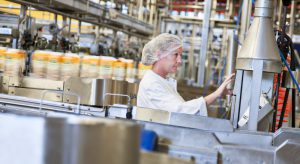
Dairy workers at Arla’s dairy in Taulov, Denmark have been joined by a robot who helps them produce delicious Danish Havarti, Danbo and Maribo cheeses.
The robot illuminates the cheese with near-infrared light through thin metal tubes inserted directly into the curd. The light emits wavelength that are stored as data about the cheese on a computer.
‘Analyzing the light allows us to map the chemical fingerprints of a cheese— including its fat, protein and carbohydrate content, among other things. In doing so, we can always see whether cheese meet the dairy’s quality standards vis-à-vis safety, texture and taste,’ said Klavs Martin Sørensen, Associate Professor at the University of Copenhagen’s Department of Food Science.
Sørensen developed the robot, partnering with Arla, the Danish Ministry of Environment and the Danish Dairy Research Foundation to ensure excellent quality.
‘The robot is unique because it monitors each cheese at a very early stage in the process. It can notify a dairy within seconds if something is off, and how. For example, the dairy should adjust a cheese’s recipe for it to be perfected again. We have never been able to monitor this before. So, the robot is the first of its kind and presents a completely new way of working with digital food production,’ explains Sørensen.
Previously, quality control in cheese making was based on individual samples taken from a whole batch of cheeses, along with the noses of dairy workers and their sense of what the cheese ought to be like.
The cheese robot enables dairies retrieve information about the quality and condition of the cheeses, which saves time and money.
‘Dairies are excited about the robot because it provides a partner that can help them nip errors in the bud instead of at the end of the process, as is the case now. They are also happy about the amount of data collected by the robot, all of which can be used to improve cheese production. The robot can never replace dairy workers, but it will be an indispensable tool for them,’ Sørensen elaborates.
The robot can also be used to investigate various sustainable production methods.
‘We will soon begin testing whether less water can be used or whether it is possible to recycle some of the water from previous cheeses in production. Here, the robot can help us determine how much water we can save without compromising quality and taste,’ states Sørensen.
He added that, in theory, the cheese robot could also be deployed to test other foodstuffs such as bread, meat or fruits.
However, the robot has only been tested at Taulov Mejeri for three months. Martins Sørensen believes it will be ready to be dispatched to several dairies in about a year.
By Marvellous Iwendi.
Source: University of Copenhagen